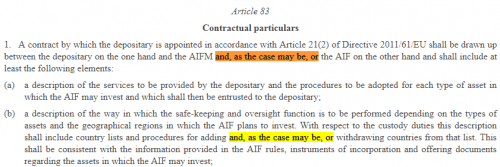And/or
|
Towards more picturesque speech™

|
And/or is the legal eagle’s equivalent of a damp kipper handshake. Avoid it. There is no more obvious sign that a text is in need of a plain English reaming.
“And/or” means “or”, because “or” includes “and”.
That’s it.
In tedious detail
“And/or” has a face only a mother could love. It is borne of the fear that, when considering alternatives any of which leads to a given outcome, things might somehow be different if they all occur.
There is no grounds for this fear. Logically, this is how one defines and and or:
- “And” is a logical operator which gives the value one if and only if all the operands are one, and otherwise has a value of zero.
- “Or” is a logical operation which gives the value one if at least one operand has the value one, and otherwise gives a value of zero.
The and/or paradox
Besides, and/or is not just ugly; it’s circular. It presents as a paradox, because of that slash. Now the slash is not a part of idiomatic punctuation in the English language. It’s a decoration with no fixed grammatical meaning. To use a slash in legal writing is to confess that the ordinary, punctuated words of the English language have defeated you.
In “and/or”, that slash means — can only mean — “or”. So by saying “and/or” you are really saying “and, or or”. But to be hermetically sealed and consistent, shouldn’t you make one further clarifying step, and say “and, and/or or”?
AND DO YOU NOW SEE THE INFINITE REGRESSION YOU HAVE SET IN MOTION?
Go back to your draft and strike all examples, and we shall never speak of this again.